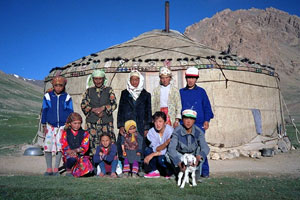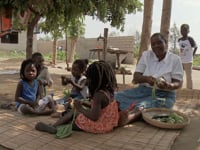1.1 Cultural nature of human development

Culture includes our values, our beliefs, and our ways of living. It is inseparable from language and in its broadest sense, encompasses everything we have learned from social experience. We cannot separate ourselves from our culture.
The graphic below shows an ecological framework in which culture is an overarching element. The habitat of the child consists of many nested layers including family members, friends, neighbourhood, possibly early childhood programs, school, and often places of faith. Less immediate forces include laws, governments, formal institutions, values, and the physical environment. However, the layers interact. For example, if there is a national policy of publicly supported health care, the child and family’s daily experience can be profoundly affected.
Think for a moment about the layers in your world in childhood – or your child’s world. How do they interrelate?
Culture is depicted as an overarching factor that crosses all of the circles. What do you think that means?
In the following video, watch a snapshot of the daily life of a group of siblings and cousins living in a family compound in a remote rural region in northeastern Afghanistan.
What did you learn about daily life for these children?
Can you think of ways in which their cultural context is influencing their experiences?
What similarities and differences do you see in comparison with children’s daily life where you live?
Socio-cultural theory
Dr. Lev Vygotsky, a Russian psychologist in the early 20th Century, understood individual human development within its social, cultural, and historical context.
Dr. Barbara Rogoff (University of California Santa Cruz) and her colleagues (2003) define human development as a cultural process that takes place through changing participation in cultural activities. Childrearing practices are based in culture and reflect local views about the world and how we should ready children to participate in that world. Rogoff discusses different cultural patterns. For example, some societies integrate children into community life while others segregate them in a “child world” (Glăveanu, 2011).
Different cultural circumstances result in very different social skills, cognitive abilities, and feelings about one’s self and others.
The study of culture and development go together: Culture is best understood historically, examining how current practices reflect past circumstances and ideas, and seeing how new generations adapt practices of those who went before. This historical approach involves the development of individuals as well as of generations. Development is best understood culturally; all people develop in the context of particular times and places” (Rogoff in Glaveanu, 2011, p.410).
Can you identify ways your culture has influenced your development?
Are children part of mainstream community life or mostly part of a ‘child world’ where you live?
In what ways has childhood changed for children who are growing up where you did today?
Bronfenbrenner’s ecological theory of human development views the individual and his or her culture as separate entities. From this perspective, culture influences the individual through characteristics of the home and community or through the more distant contexts of broader societal institutions. By contrast, Rogoff views culture as inseparable from the individual. Rogoff’s approach merges Bronfenbrenner’s view that the many layers of a child’s environment interact with Vygotsky’s view that children in all communities are cultural participants, who are living in a particular community at a specific time in history (Vélez-Agosto et al., 2017).
Experiences and expectations of childhood
The ecological model captures a basic truth about human development: there is no one ‘childhood’ just as there is no one ‘adulthood.’ Instead, every childhood is shaped by and experienced within a living context. A particular social, cultural, and physical geography sets the stage on which childhood is played out” (Woodhouse, B. 2020, p. 15).
Our views about sleeping, feeding, guidance, independence, and all the details, small and large to do with raising children, are all profoundly influenced by culture.
Variations in expectations for children make sense once we take into account different circumstances and traditions. They make sense in the context of differences in what is involved in preparing ‘a meal’ or ‘tending’ a baby, what sources of support and danger are common, who else is nearby, what the roles of local adults are and how they live, what institutions people use to organize their lives, and what goals the community has for development to mature functioning in those institutions and cultural practices” (Rogoff, 2003, p. 6).
While play is a dominant activity, in many parts of the world children are also often involved in adult tasks – caring for siblings, collecting firewood, herding cattle, working in the fields, and doing household chores. Before six or seven years of age, much of the work that young children do is regarded as play – and much of children’s play imitates work performed by adults. In many communities, children around six or seven years old become responsible for something that is work and makes a contribution to the family or community.
In many parts of the world, children have important responsibilities which can be considered as “work” that contributes to the family. Listen as Caroline Arnold, former Director of Education for the Aga Khan Foundation, discusses children’s work and why, in her view, it is not a black and white issue.
What do you think of Arnold’s comments?
Arnold distinguishes between child work and child labour. What does this mean in your context?
She also says that children’s work is an avenue to self-worth. Have you seen examples of this?
What is your experience with children’s “work”?
The next video shows children in Mozambique helping with household work. Watch as a group of siblings help their mother with the harvest by shucking cobs of dried maize and then a grandmother helps her grandchildren prepare vegetables.
Involving children, even very young children, in domestic chores is clearly part of daily life in these households.
What do you think children learn from these experiences?
The children are allowed to use knives for their work. What was your response to this?
Why would children’s participation be not only common but necessary to the households?
Did you do household chores when you were a child? If so, do your children do as much as you did?
The following reading continues the portrayal of the lives of young children in villages in Nepal but focuses on children’s work.
In some cultures, it is common for children to grow up in large extended families. In others, they live with only their immediate family – one or two parents and siblings. In the next clip, listen as Dr. Radhika Viruru, clinical professor at Texas A & M University, discusses how this can affect perceptions of childhood, specific to family environments in India.
Consider the following example of the daily life of a child from rural Nepal growing up in an extended family.
Consider…A typical day for three-year-old Jiwan, in Biskundanda
At one o’clock he is tired again, and he has another short nap inside the house where his aunt is already sleeping. When he wakes up, his brother gives him some mango and plays with him for a while…Read more
Who cares for Jiwan during the day?
What are some similarities and differences with Jiwan’s experiences in comparison with childhood where you live?
Jiwan’s childhood adheres to the phrase “it takes a village to raise a child”. What does this phrase mean to you?
Viruru also describes some other differences in how children and childhood are typically viewed in India compared to typical Western thinking.
Did you grow up in an extended or joint family? If yes, was this the common practice in your region?
How do you think this has influenced your notion of family and the roles of family members?
In your family experiences, was there a focus on individualism or interdependence? How might this impact your beliefs and practices about child-rearing?
Are things changing in your region with regard to child-rearing beliefs, practices, and/or family structures?
Shaping early development
Dr. Kang Lee’s research, at the Dr. Eric Jackman Institute of Child Study at the University of Toronto, demonstrates the power of the cultural context in shaping early development. His studies of babies’ visual attention and preferences have shown remarkable learning at very young ages. In the next clip, Lee describes the findings that babies show differences in facial preferences from a very young age, depending on their experience.
Listen as Lee explains that before a baby is even one year old, she or he will have learned the norms of their culture regarding eye contact.
Can you identify cultural influences regarding social interactions in your context?
If Kang Lee is really talking about the foundations of social belonging, can you see advantages of exposing children to different kinds of faces?
The next reading describes different cultural approaches to caregiving.
For more information on culture and learning, see the full edition of the Bernard van Leer publication Early Childhood in Focus 6: Culture and learning. This comprehensive overview describes human development and learning as cultural processes with much variability. It includes thought-provoking policy questions.





